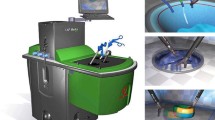Abstract
Background
Blinks are known as an indicator of visual attention and mental stress. In this study, surgeons’ mental workload was evaluated utilizing a paper assessment instrument (National Aeronautics and Space Administration Task Load Index, NASA TLX) and by examining their eye blinks. Correlation between these two assessments was reported.
Methods
Surgeons’ eye motions were video-recorded using a head-mounted eye-tracker while the surgeons performed a laparoscopic procedure on a virtual reality trainer. Blink frequency and duration were computed using computer vision technology. The level of workload experienced during the procedure was reported by surgeons using the NASA TLX.
Results
A total of 42 valid videos were recorded from 23 surgeons. After blinks were computed, videos were divided into two groups based on the blink frequency: infrequent group (≤6 blinks/min) and frequent group (more than 6 blinks/min). Surgical performance (measured by task time and trajectories of tool tips) was not significantly different between these two groups, but NASA TLX scores were significantly different. Surgeons who blinked infrequently reported a higher level of frustration (46 vs. 34, P = 0.047) and higher overall level of workload (57 vs. 47, P = 0.045) than those who blinked more frequently. The correlation coefficients (Pearson test) between NASA TLX and the blink frequency and duration were −0.17 and 0.446.
Conclusion
Reduction of blink frequency and shorter blink duration matched the increasing level of mental workload reported by surgeons. The value of using eye-tracking technology for assessment of surgeon mental workload was shown.

Similar content being viewed by others
References
Tendick F, Jennings RW, Tharp G, Stark L (1993) Sensing and manipulation problems in endoscopic surgery: experiment, analysis, and observation. Presence 2:66–81
Keehner MM, Tendick F, Meng MV et al (2004) Spatial ability, experience, and skill in laparoscopic surgery. Am J Surg 188:71–75
Cuschieri A (1995) Visual displays and visual perception in minimal access surgery. Semin Laparosc Surg 13:209–214
Berguer R, Chen J, Smith WD (2003) A comparison of the physical effort required for laparoscopic and open surgical techniques. Arch Surg 138:967–970
Berguer R, Smith WD, Chung YH (2001) Performing laparoscopic surgery is significantly more stressful for the surgeon than open surgery. Surg Endosc 15:1204–1207
Klein MI, Warm JS, Riley MA, Matthews G, Gaitonde K, Donovan JF (2008) Perceptual distortions produce multidimensional stress profiles in novice users of an endoscopic surgery simulator. Hum Factors 50:291–300
Carswell CM, Clarke D, Seales WB (2005) Assessing mental workload during laparoscopic surgery. Surg Innov 12:80–90
Cao CG (2007) Guiding navigation in colonoscopy. Surg Endosc 21:480–484
O’Connor A, Schwaitzberg SD, Cao CG (2008) How much feedback is necessary for learning to suture? Surg Endosc 22:1614–1619
Stefanidis D, Haluck R, Pham T et al (2007) Construct and face validity and task workload for laparoscopic camera navigation: virtual reality versus videotrainer systems at the SAGES Learning Center. Surg Endosc 21:1158–1164
Zheng B, Cassera MA, Martinec DV, Spaun GO, Swanstrom LL (2010) Measuring mental workload during the performance of advanced laparoscopic tasks. Surg Endosc 24:45–50
Ryu K, Myung R (2005) Evaluation of mental workload with a combined measure based on physiological indices during a dual task of tracking and mental arithmetic. Int J Ind Ergon 35:991–1009
Andreassi JL (2000) Psychophysiology: human behavior and physiological response, 4th edn. Lawrence Erlbaum Associates, London
Marshall SP (2007) Identifying cognitive state from eye metrics. Aviat Space Environ Med 78:B165–B175
Caffier PP, Erdmann U, Ullsperger P (2003) Experimental evaluation of eye-blink parameters as a drowsiness measure. Eur J Appl Physiol 89:319
Benedetto S, Pedrotti M, Minin L, Baccino T, Re A, Montanari R (2011) Driver workload and eye blink duration. Transp Res F 14:199–208
Smith P, Shah M, Lobo NDV (2000) Monitoring Head/Eye Motion for Driver Alertness with One Camera. In: Proceedings of the 15th international conference on pattern recognition (ICPR’00), Barcelona, Spain, 3–7 September 2000
Veltman JA, Gaillard AWK (1998) Physiological workload reactions to increasing levels of task difficulty. Ergonomics 41:656–669
Zheng B, Tien G, Atkins SM et al (2011) Surgeon’s vigilance in the operating room. Am J Surg 201:673–677
Jiang X, Tien G, Huang D, Zheng B, Atkins SM (2012) Capturing eye blinks from video-based eye-tracking. Behav Res Methods (accepted). Paper ID: BR-Org-12-012
Berguer R, Smith W (2006) An ergonomic comparison of robotic and laparoscopic technique: the influence of surgeon experience and task complexity. J Surg Res 134:87–92
Howard SK, Gaba DM (2004) Trainee fatigue: are new limits on work hours enough? CMAJ 170:975–976
Dexter F, Epstein RH (2006) Holiday and weekend operating room on-call staffing requirements. Anesth Analg 103:1494–1498
Zheng B, Rieder E, Cassera MA et al (2012) Quantifying mental workloads of surgeons performing natural orifice transluminal endoscopic surgery (NOTES) procedures. Surg Endosc. doi:10.1007/s00464-011-2038-x
Acknowledgments
We thank the Canadian Natural Sciences and Engineering Research Council (NSERC) and the Royal College of Physicians and Surgeons in Canada (RCPSC) Medical Education Research Grant for funding this project.
Disclosures
Dr. Neely Panton receives funds from Ethicon Endo-Surgery for fellow education and is on the scientific advisory board of Ethicon Endo-Surgery. Dr. Bin Zheng, Xianta Jiang, Geoffrey Tien, Dr. Adam Meneghetti, and Dr. Stella Atkins have no conflicts of interest or financial ties to disclose.
Author information
Authors and Affiliations
Corresponding author
Rights and permissions
About this article
Cite this article
Zheng, B., Jiang, X., Tien, G. et al. Workload assessment of surgeons: correlation between NASA TLX and blinks. Surg Endosc 26, 2746–2750 (2012). https://doi.org/10.1007/s00464-012-2268-6
Received:
Accepted:
Published:
Issue Date:
DOI: https://doi.org/10.1007/s00464-012-2268-6




